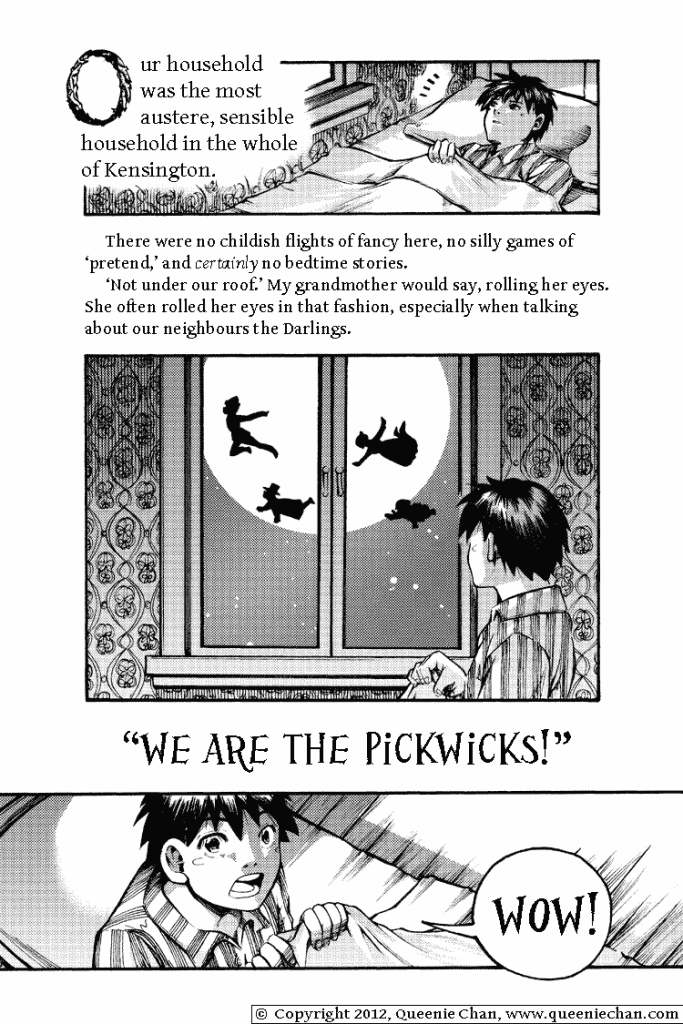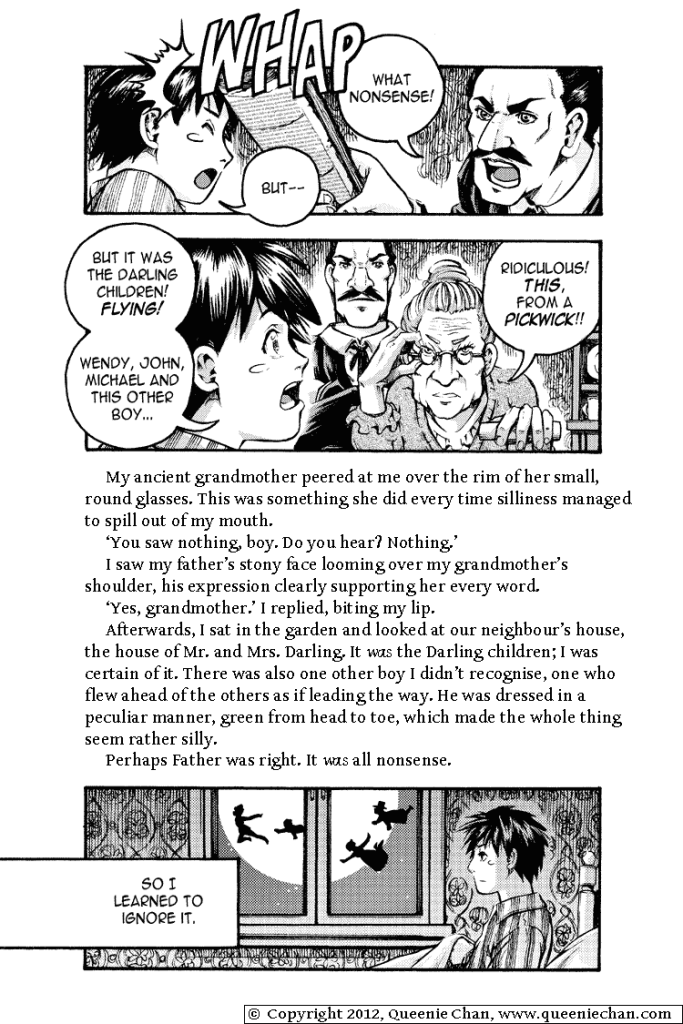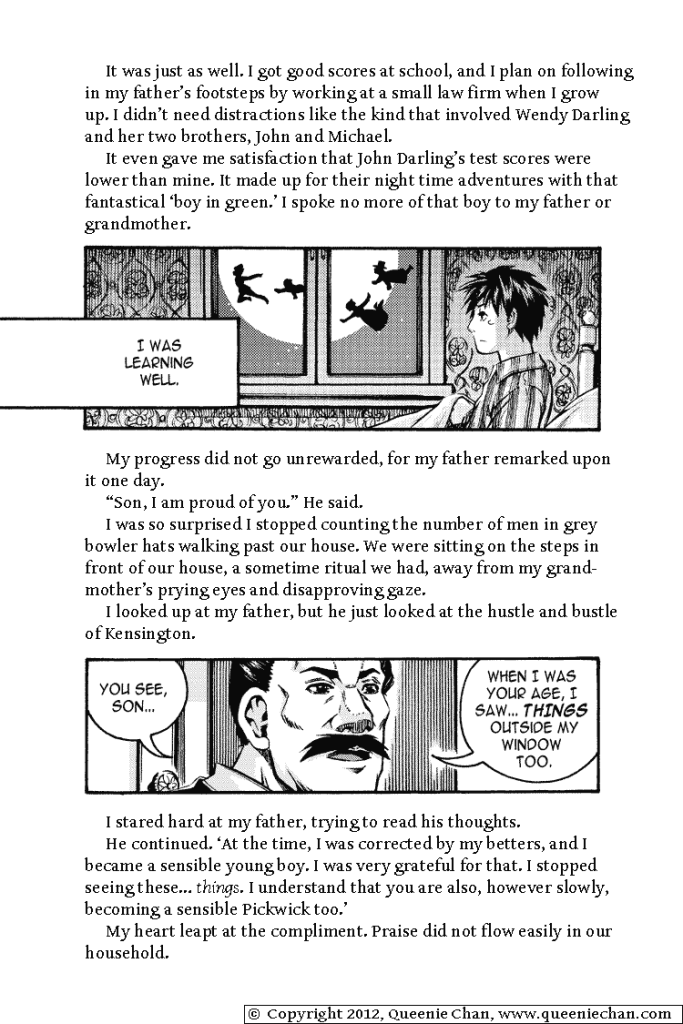Last week, House of Odd was #7 on the New York Times Bestseller List! Many thanks to Landry Walker (writer) and Dean Koontz (original creator)! I should also thank everyone who bought the book as well – I hope you all enjoyed it!
Other news this week will be my new 10-page short story, We Are The Pickwicks. This was done as part of a “Peter Pan”-themed anthology with the folks at BentoComics.com, and this time I chose to do things a little differently. I decided to mix comics and prose together, in a hybrid form I call Comics-Prose (I used to call this ‘Graphic-Prose’, but I realise ‘Comics-Prose’ is a more accurate description).



Click here to read the next page –>
What is Comics-Prose?
It’s a story-telling medium that combines both prose and comics. This is not like a picture book, where there is usually a block of text, accompanied by illustrations that may or may not have anything to do with the text. Instead, this looks to integrate the comics into the prose, to make a single, coherent narrative. Reading both the comics and the prose is necessary.
Now, I’m not the first person to combine prose and comics, but the difference here is that most attempts of this kind I’ve seen have pages of comics, followed by pages of text. This can make for an unbalanced reading experience. In comparison, I did mine with comics and prose integrated on EACH page, which means there’s no prolonged chunks of prose or comics alone. I feel it makes a more immersive reading experience.
How Did This Come About?
In 2010, I was approached by author Kylie Chan, who showed me her (yet unpublished) book Small Shen. It was the prequel to her best-selling White Tiger Fantasy series, and she asked me do something “graphic novel-related” with it. I took this to mean some kind of adaptation. Now, anyone who has ever done an adaptation knows how hard they can be. Generally, it involves taking a hacksaw to the original script and eliminating entire side-plots, so the story can fit under a certain number of comic pages. This has to be done due to time and money constraints, and like film adaptations, there’s little that can help the chopping and cutting.
I’ve always wished things were different, so when I started adapting Small Shen, I tried to preserve Kylie’s “voice” as much as possible, while still bringing engaging art to the story. Prose authors who are unfamiliar with comics can often find adaptations of their work a brutal process – comics can give the impression that it’s 50% writing, and 50% art, but that’s not really true. The real split is closer to 30% writing and 70% art. The reason for this split is because even though you can have the world’s greatest script, an incompetent artist can ruin it with bad story-telling, inexpressive art and paneling that’s hard to follow. Conversely, if you have a good artist, you can elevate an average script into a good story. This difference is even more pronounced when it comes to adaptations – the original author often finds their “voice” reduced to just tinkering with the dialogue, while the artist gives shape and form to everything else. For prose authors, who are used to being masters of their own universes, it can be deeply unsettling.
Small Shen had a lot of un-cuttable conversations, so instead of pages of talking heads in comics, I decided to just leave it in prose. This then led to leaving entire paragraphs in prose, only adding panels and pages when called for, and when I was done adapting Small Shen to script form, I had something that I found quite special. This gave me the confidence to write a short story, entirely from scratch, in such a prose-comics hybrid form. That story was We are the Pickwicks.

I think this was a very creative move you made by putting two separate types of storytelling together. If this was just a single comic, there would be more pages with too many captions and not enough visuals. In some of the comic books I’ve seen, those start with just one page having a written summary of previous events.
Using graphic prose would have worked better if you were creating the story for a magazine. I would even try the same thing if I’m more focused on writing yet I’m still able to draw. It’s good to try new things like using different concepts or putting them together and in this case, it’s not bad.
The story was very interesting and the artwork looks great. Maybe you could even try this if you continued your older stories like The Barrett Family or Keeper of the Soul. (Those were some of my favorite short stories you wrote).
Congratulations on the success of House of Odd! Keep up the great work, Queenie! 😀
Thanks. Actually, it can work fine for any kind of situation, if you ask me… it would be indeed good to do more work in this vein. But it’s likely it’ll be newer work, since “Keeper of the Soul” is just scary long, and “The Barret Family” is a continuation of “The Dreaming”.
As long as your aiming to make your story completely narrative, it’s not going to be a problem.
The reason those stories I mentioned were my favorites was because I believed they have a lot of potential to be successful if they continued. I’d actually like to see Edward and Millie Barrett having bigger roles if their story continued. I’d like to be the one to continue writing it if you won’t, but I have no idea how to do that at the moment.
I appreciate the offer, but sadly, the company that published “The Dreaming” has closed their publishing department. So even if I have material to continue the story, it looks like it won’t be happening. 🙁
Maybe no one might not see that story continue, but seeing one last sketch from you of Edward and Millie and even reading their story on the site seems good enough for me and the other fans. 🙂